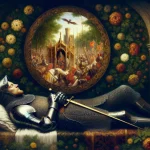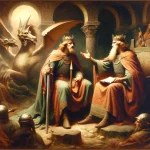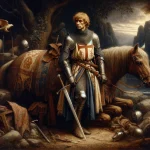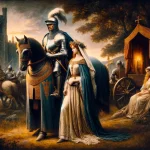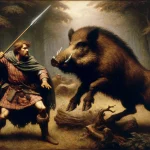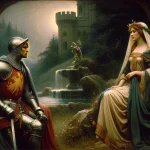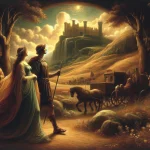The Mabinogion is a seminal collection in medieval Welsh literature, comprising the earliest prose stories from Wales and forming a significant part of the Matter of Britain. These stories, compiled in Middle Welsh during the 12th to 13th centuries, are drawn from a rich oral tradition, highlighting the enduring legacy of storytelling in Welsh culture. The primary sources for these tales are manuscripts dating from around 1350 to 1410, along with several earlier fragments, offering invaluable insights into the medieval Welsh language and narrative art.
The Tales of the Mabinogion
The Mabinogion is a collection of eleven prose stories from medieval Welsh literature. Compiled in the 12th to 13th centuries, these tales originate from earlier oral traditions. The stories of the Mabinogion are deeply rooted in Celtic mythology and culture, and they encompass a wide range of themes, characters, and narratives. The collection is divided into several sections, each with its unique characteristics:
Four Branches of the Mabinogi
The Four Branches of the Mabinogi, a key component of the Mabinogion, are particularly renowned for their sophisticated complexity. These stories stand out for their depth and narrative intricacy, defying easy categorization and highlighting the diverse themes present in the collection. Despite this diversity, some scholars debate whether these stories form a cohesive collection, underscoring the varied tapestry of themes and styles in medieval Welsh literature.
Pwyll Pendefig Dyfed (Pwyll, Prince of Dyfed): The story of Pwyll’s friendship with Arawn, the ruler of the Otherworld, and his courtship of Rhiannon.
Branwen ferch Llŷr (Branwen, Daughter of Llŷr): A tale of political intrigue and tragedy involving Branwen, married off to the King of Ireland.
Manawydan fab Llŷr (Manawydan, Son of Llŷr): Following the events of “Branwen,” this tale focuses on Manawydan and his adventures with Pryderi, Rhiannon’s son.
Math fab Mathonwy (Math, Son of Mathonwy): A complex narrative involving magic, betrayal, and the birth of Lleu Llaw Gyffes.
- The First Branch of the Mabinogi: Pwyll Pendeuc Dyfed
- Math Son of Mathonwy
- The Second Branch of the Mabinogi: Branwen Daughter of Llyr
- Manawydan mab Llŷr
Three Welsh Romances
The Three Welsh Romances (Y Tair Rhamant) are Arthurian tales in the Welsh language that parallel the narratives found in Chrétien de Troyes’ works. Scholars have engaged in debates regarding the origins of these Welsh Romances, deliberating whether they were influenced by Chrétien’s poems or if both the Welsh and Chrétien’s versions stem from a common older source. While it’s possible that the existing Welsh Romances may have been influenced, directly or indirectly, by Chrétien’s writings, it is also likely that Chrétien himself drew inspiration from earlier Celtic sources for his tales. Significantly, the Welsh adaptations are not mere translations of Chrétien’s work; they incorporate unique material absent in the French poet’s versions, indicating a distinct and possibly independent Celtic tradition in the Welsh renditions.
Owain, or the Lady of the Fountain: Based on Chrétien de Troyes’ “Yvain, the Knight of the Lion,” this romantic tale follows the knight Owain as he seeks adventure and love. After killing the knight who guards a mystical fountain, Owain marries the knight’s widow, the Lady of the Fountain. However, his obsession with knightly exploits leads to marital conflict. The story is a rich tapestry of chivalry, romance, and redemption, highlighting the Arthurian ideals of knighthood and the struggle between love and duty.
Peredur fab Efrog: Similar to the Grail quests in later Arthurian tales, “Peredur fab Efrog” is the story of a young man’s journey to become a knight of Arthur’s court. Peredur, naïve and inexperienced, faces various trials and tribulations on his quest. The narrative is filled with symbolic elements, mysterious figures, and supernatural encounters, including the enigmatic Holy Grail. This story is significant for its exploration of themes such as innocence, bravery, and the quest for knowledge and understanding.
Geraint and Enid: Echoing Chrétien de Troyes’ “Erec and Enide,” this tale explores the themes of love, honor, and fidelity. Geraint, a knight of Arthur’s court, marries Enid, a beautiful and virtuous woman. However, Geraint’s excessive love leads to jealousy and doubt, prompting a journey filled with challenges to test their love and loyalty. The narrative is notable for its exploration of the dynamics of marriage and the balance between personal honor and love in the Arthurian world.
Independent Tales
Culhwch ac Olwen: “Culhwch ac Olwen” is one of the most celebrated tales from The Mabinogion, known for being one of the earliest Arthurian stories. It is a classic hero’s quest narrative that follows Culhwch, a young man cursed by his stepmother to marry only Olwen, the daughter of the giant Ysbaddaden. Culhwch seeks the help of King Arthur and his knights to fulfill this seemingly impossible task. The story is rich in Celtic mythology, featuring a series of daunting challenges that Culhwch and Arthur’s knights must overcome to win Olwen’s hand. This tale is renowned for its detailed descriptions, humor, and the extensive list of Arthur’s knights, serving as an important source for Arthurian legend.
The Dream of Macsen Wledig: This tale blends history and legend, focusing on the Roman Emperor Magnus Maximus (Macsen Wledig in Welsh). The narrative revolves around Macsen’s dream of a beautiful maiden in a wonderful, far-off land. Upon awakening, Macsen is determined to find her, leading him to Wales. The story beautifully weaves a romantic quest with a historical figure, depicting Macsen’s journey from Rome to Britain and his eventual marriage to the maiden of his dreams. The tale is notable for its romantic elements and its portrayal of an idealized Wales, rich in beauty and splendor.
Lludd and Llefelys: This tale is a story of two brothers, King Lludd of Britain and King Llefelys of France. Lludd seeks Llefelys’ counsel to rid Britain of three supernatural plagues. The narrative is filled with magical elements and clever solutions to seemingly impossible problems, such as a dragon’s scream causing infertility in the kingdom and an invisible magician causing havoc. This story stands out for its elements of magic, wisdom, and the bond between the brothers, offering a glimpse into the mythical interpretation of historical challenges.
The Dream of Rhonabwy: Set during the reign of King Arthur, the narrative is framed around the dream of Rhonabwy, a young man of Madog’s retinue who seeks shelter in a dilapidated house. There, Rhonabwy experiences a vivid and lengthy dream in which he is transported to Arthur’s time. The story is particularly known for its rich, detailed descriptions and the juxtaposition of Rhonabwy’s contemporary medieval world with the fantastical, romanticized world of Arthur. In his dream, Rhonabwy witnesses a chess game between Arthur and Owain mab Urien, which becomes an allegory for a battle. The tale is notable for its portrayal of Arthurian characters in a light that differs significantly from traditional depictions, offering a unique and somewhat satirical view of the legendary figures. “The Dream of Rhonabwy” stands out for its exploration of themes such as time, reality, and the contrast between the idealized past and the imperfect present, making it a captivating part of Welsh literary heritage.
Other Tales
These include the story of Taliesin, the legendary bard, which is sometimes included in the Mabinogion.

